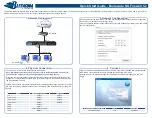
Provisioning
150-319-151-01, Revision 01
24
September 17, 1999
HLU-319 List 5A
BER Option
The BER option also uses this (BPV/CRC) TEC to generate an Alarm if enabled. The HLU combines the 1-second
TEC counts in both directions for the last 60 seconds. It uses this 1-minute Total System Error Count (TSEC) to
generate an alarm if it exceeds the selected BER threshold of (1E-6 or 1E-7) as follows:
•
BER option = 1E-6. Alarm is generated if TSEC > 92
•
BER option = 1E-7. Alarm is generated if TSEC > 9
Once initiated, the alarm clears when the TSEC drops below its associated threshold count. For dribbling errors,
the alarm can come and go in intervals as short as 1 second. Alarms due to bursty impulse noise transients usually
require the full 60 seconds or longer to clear depending on the frequency of the transients. This BER option is
always present in any line unit circuit since it is independent of other versions of HiGain modules in the circuit.
When connected to an HRU, other than the HLU-402, HLU-406, or HLU-411, only the BVPs detected by the
HLU are included in the TBC. The BPVs at the HRU are not counted.
DS0 Blocking Option
To set the DS0 Blocking option from the Main screen:
1
Press
to select the Systems Settings screen (see
2
Press
for the DS0 blocking selection. The DS0 channels are blocked or unblocked by entering each channel
number. Multiple channels can be selected by inserting a space between each entry.
3
After all the new settings have been made, press
to (Confirm) and then
for (Exit). The new choices are
now installed.
If DS0 blocking is invoked in a HiGain system that has an earlier version HRU that does not support the blocking
option, blocking only occurs at the DSX-1 output of the HLU-319 List 5A. The HRU DS1 output is not blocked.
Also, all blocked channels are temporarily unblocked for all HiGain system loopback tests for all DS1 blocking
settings. This allows the standard full bandwidth T1 loopback tests to be performed for all DS0 blocking settings.
If any of the unused DS0 channels of a fractional T1 service are filled with information other than an idle code of
all ones, the HiGain system blocks this information from reaching the remote end of the circuit and replaces those
DS0 channels with an idle code of all ones.
Blocking the idle code results in a mismatch between the CRC checksum delivered to the remote end (when the
payload is in the ESF format) and the checksum calculated by the remote T1 CSU. This implies that errors are
being made on the loop when actually the blocking function created the CRC errors. Enabled DS0 channels pass
error-free.
In order to avoid this condition, fractional T1 customers should fill the unused time slots with an idle code. This
is a common capability on Fractional T1 CSU/DSU, D4 channel banks, and other CPE devices capable of
connecting to Fractional T1 service.
&
2
&
(
















































